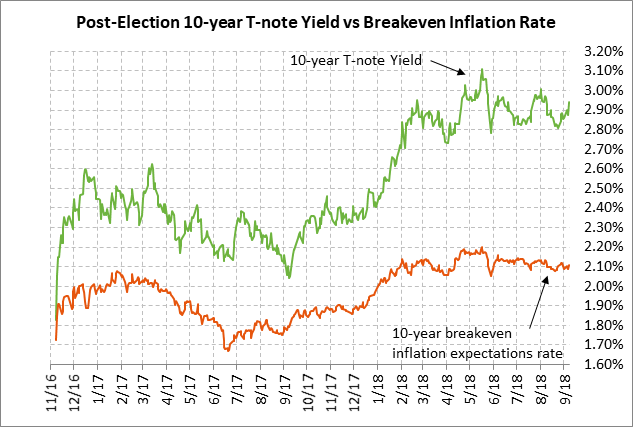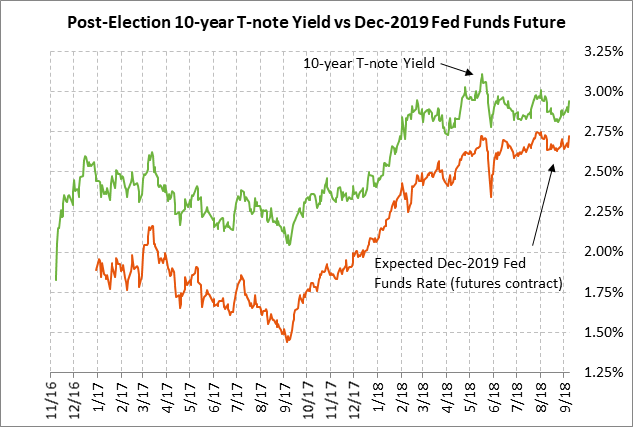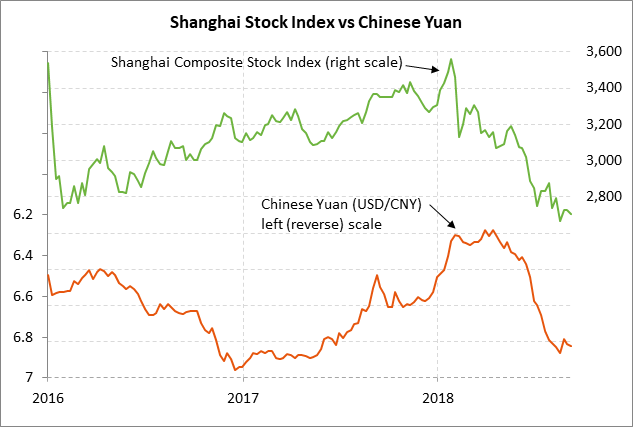- Weekly market focus
- U.S. tariffs continue to dominate market attention with USTR juggling China, Canada and Europe
Weekly market focus — The U.S. markets this week will focus on (1) trade tensions as the implementation of Chinese tariffs could be announced at any time and as US/Canadian talks on NAFTA continue, (2) Treasury supply pressures with this week’s sale of a combined $73 billion of 3-year T-notes and reopened 10-year and 30-year securities, (3) six Fed speaking engagements and Wednesday’s Fed Beige Book report as the markets look ahead to a 100% chance of an FOMC rate hike at its meeting in two weeks (Sep 25-26), (4) a very light earnings reports with only two of the S&P 500 companies scheduled to report, and (5) oil prices, which continue to consolidate moderately below July’s 3-3/4 year high as the market waits to gauge the impact of the full implementation of U.S. sanctions on Iran in November.
U.S. inflation will be front and center this week after last Friday’s report that Aug hourly earnings rose to a new 9-1/4 year high of +2.9% y/y, stronger than expectations of unchanged at +2.7%. The tight U.S. labor market has finally produced an upside breakout in earnings growth, which will be of concern to the Fed from an inflation standpoint if it continues. This week’s PPI and CPI reports are expected to show slight declines in the headline figures but unchanged core figures. The market is expecting Wednesday’s Aug PPI to ease slightly to +3.2% y/y from July’s +3.3% but the Aug core PPI is expected to be unchanged from July’s +2.7% y/y. The market is expecting Thursday’s Aug CPI to ease slightly to +2.8% y/y from July’s +2.9% but the Aug core CPI is expected to be unchanged from July’s +2.4% y/y.
The European markets this week will focus mainly on Thursday’s ECB meeting. The ECB this week is unlikely to change its current policy of ending its QE program by Dec 31 and promising not to raise interest rates until at least summer 2019. The European markets will also be watching US/EU trade tensions with US Trade Rep Lighthizer meeting today in Brussels with EU trade officials. The markets will continue to watch this week’s EU economic data to gauge the impact from tariffs and trade tensions with the U.S.
The Bank of England at its meeting on Thursday is unanimously expected to leave interest rates unchanged. The BOE just raised its base rate by +25 bp to 0.75% last month and is currently on pause while it waits for the outcome of Brexit in March 2019.
In the emerging markets, the Turkish lira and stock market can be expected to plunge anew on Thursday if the Turkish central bank at its policy meeting does not meet market expectations by raising its official interest rates. The iShares Emerging Markets stock ETF last week fell by -3.75% and is hovering just above Aug’s 14-month low.
In China, the markets will focus on trade tensions and economic data later in the week. Thursday’s Chinese Aug retail sales report is expected to be unchanged from July’s +8.8% y/y and Aug industrial production is expected to improve to +6.2% y/y from July’s +6.0%.
The Chinese trade data released this past Saturday suggested that the US/Chinese trade war may be starting to have a negative effect. Chinese Aug export growth eased to +9.8% y/y from July’s +12.2% and was slightly weaker than expectations of +10.0%. However, Aug import growth of +20.0% was stronger than expectations of +17.7% y/y, which suggested that Chinese domestic demand is still holding up well.
U.S. tariffs continue to dominate market attention with USTR juggling China, Canada and Europe — US Trade Representative Lighthizer will meet today in Brussels with EU trade officials as the U.S. and Europe try to reach a trade deal to avert the U.S. threat of 20% tariffs on European autos. The U.S. and Europe have declared a temporary ceasefire, but their talks do not appear to be going particularly well since President Trump recently said that Europe’s offer of zero reciprocal tariffs on industrial goods and autos was “not good enough” and that Europe was as bad on trade as China, except smaller.
Talks between the U.S. and Canada will continue this week on a revised NAFTA with the key sticking points being Canadian dairy support and Canada’s demand to retain the dispute panels and exceptions for cultural industries. The deadline for US/Canadian talks appears to be Sep 30, which is when the Trump administration must deliver the actual text of a revised NAFTA agreement to Congress.
Regarding China, the Trump administration can now announce the implementation of the tariffs on an additional $200 billion of Chinese goods at any time since the public comment period ended last Thursday. In the last round of U.S. tariffs on China, the USTR took until three weeks after the expiration of the public comment period to announce the implementation of the tariffs.
President Trump last Friday also threatened to slap tariffs on another $267 billion of Chinese products. President Trump said that his administration will act on the $200 billion “very soon depending on what happens,” and that “I hate to do this, but behind that is another $267 billion ready to go on short notice if I want.” Another $267 billion tranche would mean that the U.S. would then have penalty tariffs on all U.S. imports from China.
There have been no mid or high-level US/China trade meetings since the last mid-level round failed on Aug 22-24. President Trump recently said he is not interested in the deal that China is offering and that the time is not right for talks. For its part, China seems resigned to simply wait and see if President Trump is more interested in dealing after the November mid-term elections.




